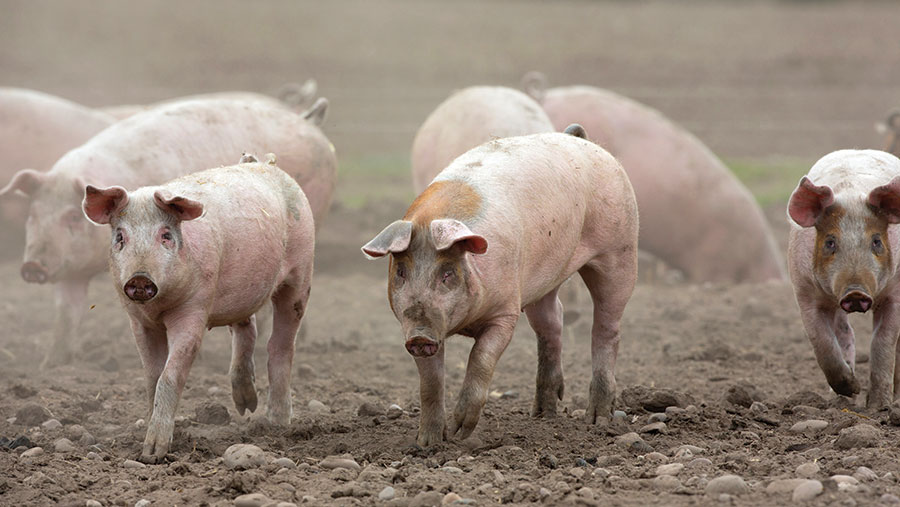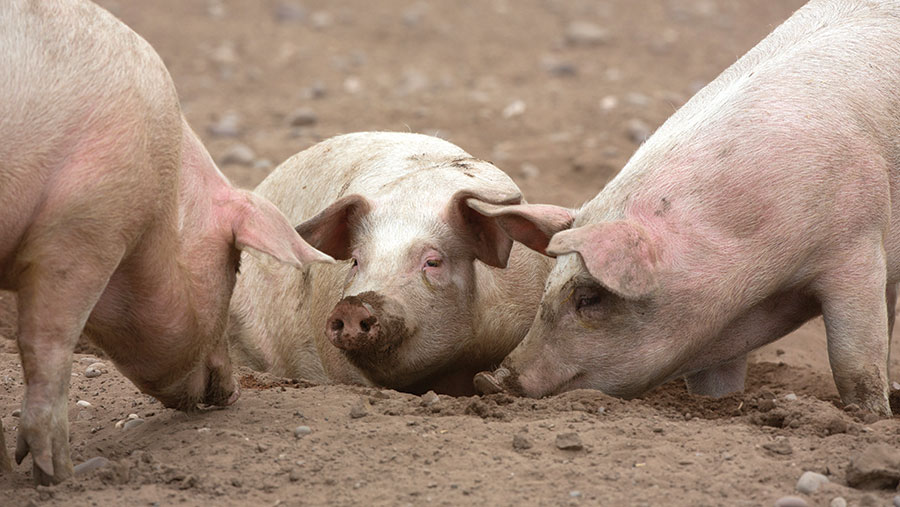Advice for selecting and managing gilts up to service
 © Tim Scrivener
© Tim Scrivener Good management and selection of gilts is fundamental for maintaining a productive herd.
Emerging evidence suggests the environment in which a gilt is reared during her suckling, nursery and finishing stages, as well as during her period as a maiden gilt, can have an effect on her lifetime performance.
What’s more, AHDB figures suggest it typically costs about £250 to rear each gilt, so putting the groundwork in to make sure they get past their first or second parity and reach their full lifetime potential is vital to get a return on that investment.
See also: Guide to maximising conception rates in gilts
Farmers Weekly spoke to Andrew Palmer and Pat Loten, knowledge exchange managers at AHDB Pork, about the key areas to focus on when it comes to improving gilt management and conception rates.
Selecting gilts
Before beginning the selection process, it’s important to ensure you have retained two-and-a-half times the number of replacement females needed.
This allows for dropouts during the selection process and ensures there is a big enough pool to pull replacements from at the stage you start to regulate their heats – about three weeks before service.
In terms of the selection criteria itself, key gilt requirements include:
- A minimum of 14 functional teats
- Good conformation
- Sound dam history: Only select gilts from sows with the best reproductive performance. Look at numbers born, numbers weaned and her farrowing index, as this will be hereditary
- Birthweight: Only choose good, strong gilts at birth that weigh more than 1kg (evidence suggests gilts born weighing less than 1kg produce 4.5 less piglets across three parities)
Another selection process should be carried out at weaning, pulling out any gilts that have not met the target weight.
- It is also important to select gilts with good weaning weights to reduce post-weaning check. Ideally, the gilt should weigh about 5kg at 21 days old, and 7kg-plus at weaning
- This target has to be flexible, as growth can be inhibited during the summer
- This second selection double checks again for any conformation issues that have appeared since the first selection at birth – for example, dipped backs, ruptures/hernias or poor legs
Final selection should be made about at 140 days or 90kg.
- Visually evaluate the legs, underline, vulva, ease of movement and overall conformation
- Growth rates and fatness – or leanness – should also be taken into account during the final selection process
Feeding the gilt
Gilts that have made it through the selection process can stay within the regular grower/finisher group on the normal ration until they reach 80kg.
They should then be removed from the commercial flow and managed separately.
The use of a gilt ration is important to allow adequate growth rates, fat deposition and bone growth at this key stage.
As a result, a key component of the diet should be calcium phosphorus, as this is one of the main drivers for promoting bone strength and good growth rates.
Three weeks before their first service (when gilts weigh about 140kg), they should receive ad-lib quantities of feed to cause a reproductive flush, which subsequently improves egg numbers and egg quality.
Vaccinating the gilt
Vaccinations will depend on herd health status and the status of the incoming gilts. Any vaccinations should be given in discussion with your vet and in line with your herd health plan.
The most common vaccinations include erysipelas (x2), parvovirus and porcine reproductive and respiratory syndrome (PRRS).
Other vaccines should cover enzootic pneumonia, porcine circovirus disease (PCVD), clostridia, and E coli.
A controlled-exposure technique can be used to “bug up” the gilts to your farm’s specific pathogens. As an example, old bedding could be used to allow them to build up an immunity to these pathogens.

© Tim Scrivener
Measuring gilt development
Gilt performance makes up 20-25% of a herd’s total performance at any time. Good gilt management will help to optimise sow longevity by reducing the number of prematurely culled animals (culled before parity three)
Keeping track of changes in performance over time means you learn what works for your unit, in terms of herd management and environment, motivating yourself and the team to do more of this. It also provides early warning if performance starts to deteriorate.
As a general rule, during gilt development producers should be looking to monitor:
- Birth weight (more than 1kg)
- Conformation – good legs, udder line and general body shape
- Weaning weight – target 7kg
- Serve at 220-240 days,140-150kg liveweight with 18mm backfat
- Conception rate – target 95%
- Farrowing rate – target 5% more than the herd average for sows
- Total piglets born alive – a gilt will generally produce one less piglet than a sow per litter, so target your herd average minus one (AHDB sow average = 14.84)
- Born alive – target more than 12 piglets
- Reared – target more than 11 piglets
Preparing for service
Low birthweight will increase early removal from the herd due to anoestrus (lack of heat) before first mating, and gilts weighing less than 1kg at birth often produce fewer total born piglets at the first farrowing and consequent litters.
When preparing gilts for service, typical targets to look for include:
- 135-170kg liveweight
- 220-270 days of age
- Body condition score of 3-3.5
Where a progestagen is used to control oestrus, there are a number of best-practice principles that should be followed to ensure at least 90%+ of gilts are cycling five to seven days after withdrawal.
- Ensure the gilt has already reached puberty and do not start the programme if the gilt is already in oestrus
- Try to feed the gilts individually or use a new oral doser; gilts can be trained with apple juice or cod liver oil
- If group feeding, initially give 1kg of feed plus the progestagen per gilt; distribute, allowing sufficient space for the gilt to eat her allocation and then feed the remaining daily allowance once the treated food has been consumed
- Once the progestogen has been withdrawn, gilts should be placed on ad-lib feeding and receive daily boar contact to stimulate oestrus as normal
From a stockperson’s perspective, it is important gilts are familiar with both the routine of moving to the heat detection/AI facilities and they are also allowed to explore the area, including meeting the boars.
Familiarisation will reduce stress, promote calm gilt behaviour and strong standing reflexes during insemination.
